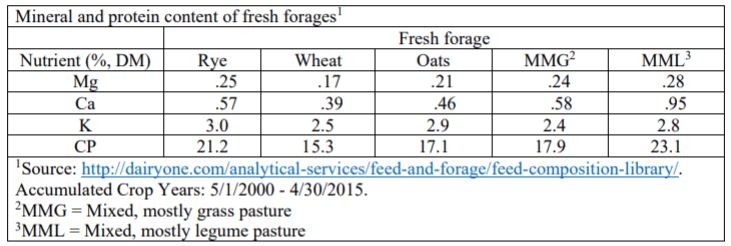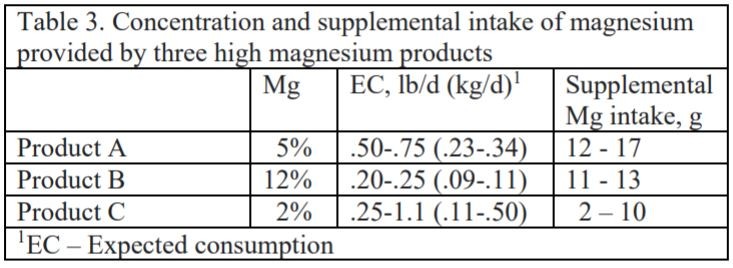It's That Time of Year - Managing to Prevent Grass Tetany
CORNELL BEEF PRODUCTION REFERENCE MANUAL
Michael J. Baker
(Frank E. Woodson, West Virginia University-original author)
Cornell University
Department of Animal Science and Cornell Cooperative Extension
Fact Sheet 3103
Revised January 2016
Grass Tetany in Beef Cattle
The Condition
Low blood magnesium (hypomagnesemia) is a complex metabolic condition aggravated by stresses such as lactation, weather, fatigue or excitement. Consumption of forages such as lush grass pastures or green cereal crops (cover crops) in which magnesium is low can reduce blood magnesium and precipitate the highly fatal crisis called tetany. Adult lactating animals are most susceptible because of the loss of Mg in milk and their inability to mobilize Mg bone reserves. Tetany usually occurs near parturition and/or until approximately 2 months postpartum, and the frequency usually increases with older cows. It is rare in non-lactating animals unless they were undernourished and turned into lush pasture or a green cover crop. Cool, rainy weather can increase the incidence of this disease.
Magnesium Requirement
The average lactating beef cow must consume 22 to 25 grams of Mg daily to supply her body needs. This is a complex disease, because several minerals have been shown to be involved. For example, the greatest risk for grass tetany is when pasture soils are low in available magnesium and calcium, high in available potassium and high in nitrogen. Now, as soils vary in mineral and nitrogen content, so do the plants living in these soils. Specifically, for a minimum tetany risk forages should contain 0.2% Mg; those with Mg levels between 0.1% and 0.2% are considered a low to moderate tetany risk, while values below 0.1% indicate a high tetany risk. Forages that contain more than 3 percent potassium and more than 4 percent nitrogen (25 percent crude protein) are likely candidates to create grass tetany problems. In addition, cows often do not develop signs of tetany until blood calcium concentrations drop below 0.8 mg/dL.
With the increased interest in planting and grazing annual cover crops, producers need to be aware that doing so increases the risk of tetany because the mineral content is different than in perennial forages (Table 1). Note that of the cover crops, wheat has the greatest potential to cause tetany because of its low Mg and Ca levels, whereas Rye would pose the least risk. Incorporation of legumes generally eliminates the risk of tetany; this can be seen as the mixed mostly legume pasture has a high level of Mg and Ca. Finally, note that the values in Table 1 are averages. With the exception of the mixed mostly legume pasture, all of the forages had a minimum Mg concentration that was considered to be in the moderate to high tetany risk.

Heavily manured pastures can create a mineral imbalance of Mg, Ca and K and as such, are considered more risky. High rates of nitrogen and potassium fertilizer are sometimes associated with increased tetany problems. Soil and forage testing is highly recommended as a valuable tool to provide insight into potential problems.
Seasonality
Tetany can occur at several times of the year under quite different feeding/management conditions. "Transitional" tetany occurs in early spring when grasses are first beginning to "green up." At this time consumption of the wintering ration often drops markedly because cows prefer the early grasses. The classical "grass" or "spring" tetany occurs in the spring when cattle are turned out to graze lush small grains or pasture grasses. Though rare, "Autumn" tetany occurs similarly to "spring" tetany on lush grass of fall regrowth.
Symptoms
Often the first and only observed sign of tetany is the finding of a dead cow, since the time from onset to death may be less than an hour. Usually, affected cows will be mature and at the peak of lactation, although tetany may occur before calving or later in lactation. If observed, the cow may run aimlessly with incoordination and fall undergoing a convulsion with leg paddling and head throwing. In less acute cases, a cow may be excitable and "wild eyed." urinate frequently, walk with staggering or stiff gait, exaggerated "high" stepping, or trembling of heavy muscles. These signs may continue or re-occur for hours or even a day or more before worsening to convulsions and death. Cattle that develop tetany are more prone to do so again. They should either be culled or placed on a different management program.
Prevention.
The key to successful tetany prevention is an assured daily intake of the required amount of Mg supplement. When this is accomplished the incidence of tetany will be minimized. However, since prevention is dependent upon voluntary intake by every susceptible cow, anything which interferes with access to or consumption of the Mg supplement can precipitate tetany. Management, cow health and supplement palatability all play vital roles in promoting voluntary intake. Herdsmen must be able to recognize and compensate for such things as digestive disturbances or other diseases which may cause a cow to go off feed. Calving cows isolating themselves from sources of supplemental Mg and weak or shy cows do not get an adequate share due to feeding competition.
Methods of Supplementing Mg
The prime considerations in selecting the method to supplement Mg are 1) effectiveness and 2) adaptability to feeding/management system. In tetany prone areas, cost, within reason, is of secondary importance. Magnesium oxide is the primary source of Mg in mineral supplements and it is unpalatable which results in low mineral intake. Therefore it needs to be mixed with feeds to assure adequate intake.
1. Top dressing silage by uniformly sprinkling 1 to 2 oz of magnesium oxide (MgO) or equivalent per cow daily on silage as fed has proven to be highly effective. If bunk space permits all cows to consume their share of the treated layer, it eliminates many intake problems associated with other methods and has the lowest cost.
2. Fortifying grain by mixing 1 lb MgO or equivalent in 15 lb of ground corn or other grain mix and feeding 1 to 2 lb per cow per day. In high risk herds fed only 1 lb per cow per day, the mixing ratio should be 1 lb MgO to 7 lb grain. This method has proven to be very effective, but is relatively more expensive and labor intensive.
A vital requirement of this method is adequate trough design and space to permit all cows to feed without disturbance at one time. Otherwise, shy or weak cows will have inadequate intake. When properly designed this is the best assurance that all cattle are consuming required amount of Mg.
3. Fortifying water by spiking with a soluble Mg salt. Magnesium oxide, is insoluble in water and cannot be used for this purpose. Magnesium acetate, magnesium chloride, and magnesium sulfate (Epsom salts) are soluble and can be used.
4. Loose mineral or Mg blocks/tubs. Each delivery method has advantages and disadvantages. The most important factor to consider is intake of Mg. Not all products contain the same concentration of Mg, so it is important to monitor actual Mg consumption. Remember the recommended total intake of Mg is 22 to 25 g of Mg/day.
Let's do a little math.

For cows on mixed mostly legume pastures, where the average Mg concentration is 0.2%, they will meet their recommended minimum daily intake of Mg (25 g). Cows grazing a wheat cover crop will not meet her requirement without supplementation (13 g).

Each of the above products in Table 3 provide varying levels of intake and magnesium supplementation. Product A has the highest expected consumption and the highest Mg supplementation. The Mg concentration of your pasture/hay, would determine if Product A is price competitive. For example, if you were grazing a wheat cover crop, the extra Mg would reduce the risk of grass tetany. However if you were grazing a pasture with >30% legumes, then no supplementation might be necessary, especially if you had no history of tetany. Also beware that some products which are advertised as aids in tetany prevention, may only to so when the diet is just barely deficient in magnesium (e.g. Product C in Table 3).
For those interested in mixing your own free-choice supplement the following has had some success in herds with moderate to low tetany risk:
- 25% MgO
- 25% trace mineral salt
- 25% dicalcium phosphate
- 25% ground corn
Treatment
Treatment of cows in the early stages of grass tetany can be effective, but animals should be handled quietly and gently, producing the least stress and exertion possible. Any stress that causes excitement such as rough handling, even moving can result in sudden death. A common treatment is a sterile solution of magnesium sulfate given subcutaneously. Producers that have experienced grass tetany should contact their herd health veterinarian. As a follow-up treatment, the animal should be removed from the tetany-producing pasture and fed hay and concentrates. Also, approximately 30 grams of Mg sulfate should be given daily. Cows that have grass tetany are more likely to get it again later in the season or in future years.
Management recommendations:
1. Do not allow cows to graze early growing pastures with limited yield-as they will eat less hay which increases tetany risk.
2. Graze less susceptible animals on high risk pastures. Steers, heifers, dry cows, and cows with calves over 4 months old are less tetany prone.
3. Including legumes at >30% in pasture mixes will decrease the incidence of tetany in grazing cattle.
4. In herds at high risk even dry cows in advanced pregnancy are susceptible, so begin supplementing Mg four to six weeks before calving. Continue supplementation until three to four weeks after turning out to pasture.
5. Cattle that develop tetany are more prone to do so again. They should either be culled or placed on a different management program.
6. Test soils and forages to determine tetany risk
Resources
Lemenager, R, Bridges, A, Claeys M, and Johnson, K. "Spring pastures - grass tetany and bloat". Purdue University Departments of Animal Sciences1 and Agronomy
Kvasnicka, B and Krysl, L. J. "Grass Tetany in Beef Cattle". Beef Cattle Resource Committee. BCH-3110
Stewart, A. J. 2013 "Hypomagnesemic Tetany in Cattle and Sheep" The Merck Veterinary Manual.
Woodson, F. E. 1977. "Feeding supplementary magnesium to prevent grass tetany". Cornell Beef Production Reference Manual. Fact Sheet 3103
Upcoming Events
Cover Crop Breeding Field Walk
May 1, 2024
Freeville, NY
You're invited to join us for a Cover Crop Breeding Field Walk!
The Cover Crop Breeding Network breeds fall-sown cover crops for traits like fall emergence, winter survival, spring vigor, high biomass, hard seed, and non-shattering pods
Join us to walk the trial fields, talk about what we're seeing (and not seeing), hear about past years' results, and learn about CCB lines approaching commercialization.
Advanced line trials - Crimson clover, hairy vetch, winter pea, and winter canola
Planting date trials - Cereal rye and winter pea
Breeding nurseries - Cereal rye and winter pea (across the road & optional!)
Meat Your Farmer 2024
May 2, 2024 : Meat Your Farmer 2024
East Aurora, NY
This event brings together livestock farmers and the community to learn about local bulk meat sales and to taste recipes created for NYS schools, featuring meats from local farms. We are currently looking for farmers to participate in the event!
Western NY Value-Added Dairy Discussion Group: Jess May- Farm Credit East Webinar
May 2, 2024
We will start our Value-Added Dairy Processing discussion group series with a guest speaker from Farm Credit East. On May 2nd at noon, Jess May will join us to discuss the lender's point of view for on-farm processing and diversification. This is free to join and will be recorded.
Announcements
No announcements at this time.





